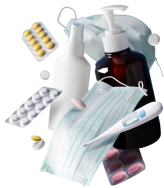Healthwire Pharmacy provides 100% genuine medicines straight to your doorstep.
Order Now! & Avail
Upto 10% OFF On All Your Pharmacy Orders!
Cefixime 400mg
Healthwire Pharmacy Ratings & Reviews (1500+)
Product Information
Cefixime 400mg capsules exhibit their antibacterial activity through a specific mechanism of action. Cefixime primarily inhibits bacterial cell wall synthesis by binding to and blocking the activity of penicillin-binding proteins (PBPs), which are essential enzymes responsible for cross-linking peptidoglycan strands in the bacterial cell wall. By inhibiting PBPs, Cefixime disrupts the formation of a strong and stable cell wall, leading to weakened bacterial cell structure and ultimately cell lysis. This mechanism is particularly effective against susceptible bacteria, as it interferes with a vital process required for their growth and survival.
Cefixime 400mg
Cephalosporin antibiotic
Capsule
The following are the uses of Cefixime 400mg Capsule:
Tailoring Treatment for Optimal Health, Prescribed Medication Dosage is:
In the case of an overdose of Cefixime 400mg Capsules, it is important to recognize the signs and symptoms, which may include nausea, vomiting, diarrhea, and abdominal pain. If an overdose is suspected, seek medical advice promptly. Treatment may involve monitoring and supportive care, ensuring the patient's vital signs are stable and managing any adverse effects. Quick action can help prevent potential complications and ensure the best possible outcome. Always keep medications out of reach of children to prevent accidental ingestion.
In the case of a missed dose of Cefixime 400mg Capsule, it is recommended to take the missed dose as soon as you remember. However, if it is almost time for your next scheduled dose, skip the missed dose and continue with your regular dosing schedule. It is important not to double the dose to make up for a missed one, as this may increase the risk of side effects. If you miss multiple doses, contact your healthcare provider for guidance on how to resume your medication safely. Always consult your doctor or pharmacist if you are unsure about how to manage missed doses.
To take Cefixime 400mg Capsule, swallow the capsule whole with a full glass of water, preferably at the same time each day, either with or without food, as directed by your healthcare professional.
Here are the circumstances where Cefixime 400mg Capsule should not be administered:
The side effects of Cefixime 400mg Capsule may include:
Following are the precautions and warnings for Cefixime 400mg Capsule:
Following are the drug interactions for Cefixime 400mg Capsule:
Following are the food interactions for Cefixime 400mg Capsule:
Cefixime 400mg capsules should be stored in a cool and dry place, preferably at room temperature, ensuring protection from direct exposure to sunlight and moisture. Keep the medication in its original packaging, tightly sealed, to maintain its integrity and prevent contamination. It is crucial to store it away from heat sources like heaters or ovens, as temperature fluctuations can impact its effectiveness. Dispose of any unused or expired capsules responsibly; do not flush them or pour them down the drain. Consult a pharmacist or healthcare professional for appropriate disposal methods. Always keep medications out of children's reach to prevent accidental consumption.
Following are the quick tips for Cefixime 400mg Capsule:
Cefixime is a medication that belongs to the antibiotic class of drugs and is known to be effective in treating various bacterial infections. While it can be quite effective, it is important to stress that this medication does have its potential drawbacks and side effects just like any other medication.One of the most important things to note about Cefixime is that it is not suitable for everyone. There is a possibility that this medication could interact negatively with other medications that the patient is currently taking, or it may exacerbate certain medical conditions that the patient is dealing with or cause allergic reactions due to pre-existing allergies. Thus, it is crucial to inform your healthcare provider of all your medical history and the medications you take.In terms of the clinical implications, it is recommended that patients undergo certain laboratory tests while using this medication. Such tests include monitoring kidney function through blood tests that examine serum creatinine and blood urea nitrogen levels. These tests are important because this medication does put stress on the kidneys, and as a result, it is important to ensure that the kidneys are functioning properly. If they are not, it might be necessary to adjust the dosage of Cefixime or consider alternative treatment options. Given that this medication can cause bleeding issues in some patients, it is possible that your doctor will also want to monitor your complete blood count (CBC). This will help ensure that your blood is healthy and free of abnormalities, such as low levels of platelets, which are critical for healthy blood clotting. Remember, however, that these tests are not mandatory for everyone taking Cefixime. Their necessity will depend on individual circumstances and the opinions of healthcare professionals. In summary, whilst Cefixime is a useful medication for fighting bacterial infections, at any point you experience side effects or notice anything abnormal whilst taking this medication, you should consult a medical professional who can provide personalized advice, and if needed, recommend alternative treatment options.

Order Now! & Avail
Upto 10% OFF On All Your Pharmacy Orders!

If you face any issue, feel free to contact us. We provide 24/7 support to assist your problems